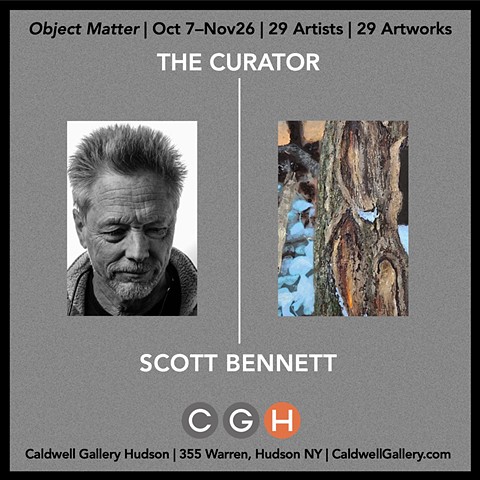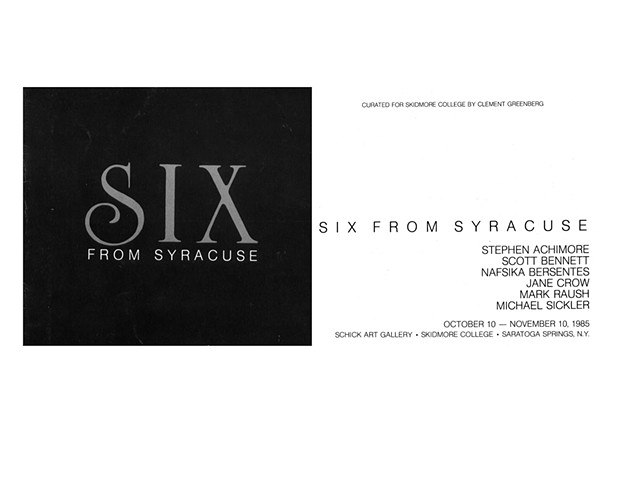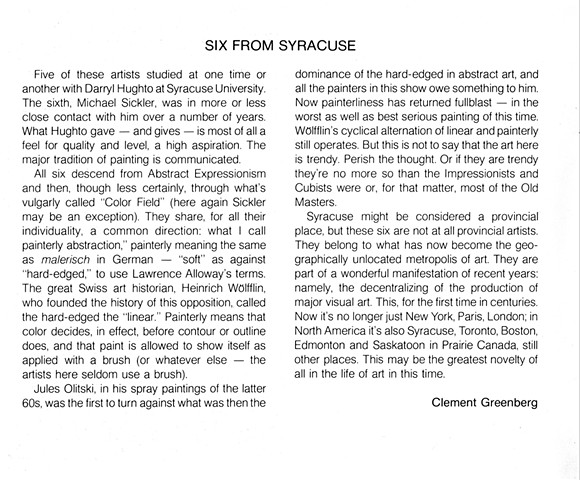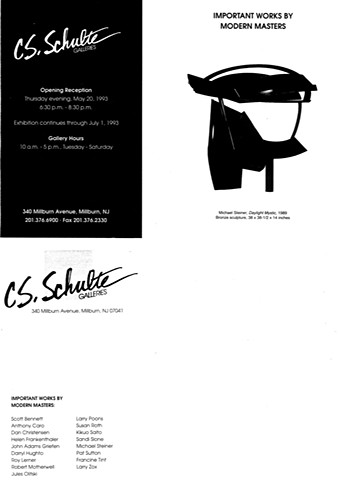Opening Night
Solo Show at Chamot Gallery - Opening Night
Solo Show: Chamot Gallery 2025
Solo Show: Chamot Gallery 2025
Solo Show at Chamot Gallery
Chamot Gallery, Fayetteville, NY - open by appointment. 347-228-8890
Tree Portrait Book Available in Hardcover and Softcover - soon on Amazon
Alex Grimley Visit
In February 2025 the art historian and writer Alex Grimley came to see a selection of my work. The original purpose was to look at my Tree Portraits in preparation for writing an introduction to a book on this series. The book should be published sometime in 2025 and will be available on Amazon. He also looked at some of my newest works which I have been working on since late 2024. They could be viewed or thought of as abstract landscapes but veer into more non-objective territory as well. They are the works that have my most intense focus currently.Alex wrote an essay for the online catalogue for a large group exhibition I curated for Caldwell Gallery in Hudson NY in 2023.
He has written essays on Kenneth Noland, the Washington Color School, and Jules Olitski for major exhibitions at Yares Art. In 2022, he authored the gallery’s Jules Olitski 100 Years, 100 Paintings: A Centennial Exhibition. His essays have also appeared in exhibition catalogues for Paul Kasmin Gallery, Upsilon Gallery, and Hollis Taggart Gallery, among others. He’s written on contemporary landscape for Root Quarterly, and he is a regular art reviewer for The Brooklyn Rail.
For more information about Alex Grimley -
https://alexgrimley.com/about/
At Opening of "About Color" at Novado Gallery
"About Color" at Novado Gallery
Curated Exhibit of 29 artists at Caldwell Gallery Hudson
Object Matter Exhibition - curated by Scott Bennett
Press Release:
www.caldwellgallery.com/exhibitions-items/object-matter/press-releaseObject Matter Exhibition Catalogue -
www.caldwellgallery.com/attachment/en/5cfe92e5a5aa2ca45b8b4567/TextTwoColumnsWithFile/64c56832388aa07689003ef9The Weird Show Interview - Andrea Burgay interviews me in my studio. See the interview at the link below.
Work at The Painting Center in NYC
The Indivisible Spectrum, Curators Selections: Feb 1 - 26, 2022
Opening Reception, Thursday Feb 3, 5-8pm
547 West 27th Street, Suite 500, NYC, NY 10001
www.thepaintingcenter.org/theindivisiblespectrum
https://m.facebook.com/watch/?v=439165267999546The Sea Stacks of Scott Bennett - Essay for a catalogue by Franklin Einspruch
While there are pictures that are abstract from conception onward, a lot of abstractions have been abstracted from some other process of art-making. The abstractionists themselves, generally, are not interested in purity. This is particularly true in the case of Scott Bennett. As a younger abstractionist, he was advised by no less than Clement Greenberg to enlarge some landscape studies he had painted into more fully developed canvases. (One must beware what Rackstraw Downes once called “the pitiful myopia of standard art history)
Bennett subsequently developed an able, convincing technique of landscape painting, and he could have settled for his lot as a nature painter of respectable rank such as that can be attained nowadays. But that was never his goal. Rather, he was engaged in an interrogation, via intuition, of the mechanisms by which pictures work. That is the essence of the modernist project, and when he turned back to abstraction those mechanisms continued to operate. Figurative functioning persisted even depiction dropped off.
This is apparent in a series that he calls the Sea Stack paintings. They include forms recognizable as some kind of stony island in front of an ocean, horizon line running behind the mass in the foreground, and sky extending to three edges of the rectangle. Semblance to any coast ends there. Sea, stack, and sky are wholly invented, wild in coloration and rendered in a spirit of experiment.The Sea Stacks capitalize on the fact that the landscape archetype in the human psyche is so firmly ingrained that you can put the analogous forms down in nearly any way you like so long as they have some aesthetic urgency to back them up. That enables the clouds shaped like sofa cushions in Sea Stack Song and the cranberry-dotted waters of Smoke Ring. It may sound comic to describe them like that, and they do have an element of humor. But they are anxious as well, and a little anxiety-provoking on account of their profound strangeness. They are uncomfortable in a way that his tree pictures never were. The discomfort is not for its own sake but a mechanism to get into an original and vital mode of working.
Mountain Song has a sky full of fluid dispersions, while the round chunk of paint in Sea Stack in an Emerald Sea looks like it was peeled dry out of the bottom of a container and mashed into wet paint already on the canvas. This wide vocabulary derives from a technical knowledge of acrylic paint that is hard for the untrained to appreciate, just as it is hard to appreciate music fully if you don’t know about keys and time signatures. The abstractionist gives up, along with imagery, the obvious virtuosity of mimesis. But in the Sea Stacks, Bennett’s skill appears in the odd but inarguable choices around color combinations and form-making. Through his powers, the scenes come alive like beasts.
Short Bio 2021
Scott Bennett received his BFA from Syracuse University in 1974. Early in his career, he met the critic and writer Clement Greenberg who had previously selected Bennett's work for inclusion in juried exhibitions at the Silvermine Guild in Connecticut and the Biennial at the Everson Museum in Syracuse. The friendship and studio relationship with Greenberg became a vital and important part of Bennett's artistic development.In 1985 attended Triangle International Artists Workshop in Pine Plains, NY, founded by the sculptor, Sir Anthony Caro. Met like minded-painters from Canada, England and the USA. Larry Poons, Helen Frankenthaler, and Friedl Dzubas were visiting artists. Karen Wilkin, in the 2005 catalogue to the exhibition, The Mirror Eye; Greenberg in Syracuse, wrote,..”Bennett’s brand of figuration suggests new readings of his abstract paintings, hinting at previously unimagined allusions to the natural world." In the same catalogue, Suzanne Shane continues with this theme,..."Scott Bennett's abstract work of the late 70's and 80's provides a foundation, a set of techniques and structures for exploring the complex textures and surfaces that inform his later work."
Bennett has been a visiting artist at Tokyo University in Japan, Southern Indiana University, Oswego State University and the College of Visual Arts in St. Paul, Minnesota.
His paintings are in numerous domestic and international collections. He lives and works in upstate New York.
Review at Art Critical.com
"Scott Bennett has three good-sized acrylics, each lovingly portraying the trunk of a single tree in a landscape setting. Paint application is luscious. Forms are large and gracious. Colors are rich and vigorous. Pansdance has the most humanoid tree trunk, its bluish grays offering a dignified contrast with the riotous green of the field beyond." - See more at: http://www.artcritical.com/2014/05/26/piri-halasz-on-joan-mitchell-and-trees/#sthash.FZD3N9ww.dpufPiri Halasz: Review at Art Critical.com
At Triangle Workshop 1986
Review of Exhibition at Tabla Rasa Gallery
"As a group, I was most impressed by the three acrylics of Scott Bennett—not least because I love color, and these were the most colorful canvases in the show. Also, I responded to the thick, luscious paint, lavishly applied, and the almost voluptuous shapes of the three different tree trunks—each canvas has one tree trunk as its centerpiece (sometimes with hints of other trees in the background as well). All three of these paintings are very good, but “Lightness of Being” has the subtlest, most closely valued color scheme, avoiding the poison green in the backgrounds of the other two."Piri Halasz - From the Mayors Doorstep, May 2014, review of Intimate Forest Exhibition at Tabla Rasa Gallery.
From catalogue to the exhibition Six from Syracuse 1985
"….Now painterliness has returned fullblast - in the worst as well as the best serious painting of this time. Wolfflin's cyclical alternation of linear and painterly still operates. But this is not to say that the art here is trendy. Perish the thought. Or if they are trendy they're no more so than the impressionists and Cubists were or, for that matter, most of the Old Masters.Syracuse might be considered a provincial place, but these six are not at all provincial artists. They belong to what has now become the geographically unlocated metropolis of art. They are part of a wonderful manifestation of recent years: namely, the decentralizing of the production of major visual art. This, for the first time in centuries. Now it's no longer just New York, Paris, London; in North America it's also Syracuse, Toronto, Boston, Edmonton and Saskatoon in Prairie Canada, still other places. This may be the greatest novelty of all in the life of art in this time."
Clement Greenberg, 1985
Six from Syracuse
Artist Statement 2012
In the text of the catalogue from a Bonnard exhibit at the Metropolitan Museum of Art, I read that there is a renewed interest in his work, and that the general art establishment is now acknowledging Bonnard’s greatness and his advanced pictorial and color sensibility. These attributes were there all along of course, and I often wonder what it is that makes some painting harder to see, or at least harder to see how good it is.Bonnard was a favorite painter of mine when I was an art student, and I remember feeling that I wasn’t supposed to like his work, that it was rated below Matisse, for instance, or somehow second rate. That was back in the 70’s. It seems that this idea had filtered down and settled in to Art history and was being conveyed to art students, directly and indirectly.
I find comfort reading about past artist’s lives, choosing to sublimate or ignore the inevitable sad parts, and to bask in the feeling of being a part of a very large family. I relate to Bonnard’s sometimes self- deprecating manner, the way that he fussed over his pictures, and his often quirky sense of composition. I find it comforting to be part of a very long and rich tradition.
Around 1991, I turned to representation after 16 years of making non-objective pictures. While I’d always drawn and painted from nature, this was the first time it would be the focus of my picture making. The change had to do with exploring new territory ambitiously and the belief that what matters first is the quality or level of the work. The best of the past is always there to remind me.
By making that choice, I opened up a lot of territory. Now that I am back to making non-objective pictures, along with still life and landscape, I find that I have fewer habits or hidden pre-conceptions about picture making. I am enjoying the flow between what could be called “easel painting’ techniques – certain types of brushwork that imply the hand and wrist – and broader, more modern types of paint handling that often hide the hand and employ larger or alternative tools.
Many times, the horizon would drop out of my landscape pictures and the imagery would be more about the complexity of the ground, with its grasses, sedges, dried twigs, lichens, etc. It seemed, perhaps, to be my way of merging all-over abstraction or non-objective picture making with representation. My close-up paintings of tree trunks, that I often think of as “Tree Portraits” are another type that enables this fertile hybridization. I have always been fascinated with microenvironments and as a child in Northern New Jersey, spent whole summers studying the forest floor and all its inhabitants. The tree portraits and ground type pictures, in particular, are an outgrowth of this long-time fascination.
The poet and writer, Suzanne Shane wrote about my “ground-type” paintings on the occasion of a solo exhibit at CS Schulte Galleries:
“In his recent work, Scott Bennett is not merely painting landscapes; he is reinvigorating landscape. Land forms (rock outcrop, crevice, minutiae of root, leaf, fauna) inspire rather than dictate the composition of these paintings, so that even boulders might float or retreat into pools…..”
“Bennett’s eye is often that of a zoom lens, framing his material so that expansiveness is implied; we have entered a microcosm whose beauty exists in the tension between infinite precision and loose rhythmic pattern. “Alpine Jewel” is a virtual tapestry of undergrowth, the slick stones glimmering, the diversity of the textures enhancing the richness of the whole.”Karen Wilkin, in the catalogue to the exhibition, The Mirror Eye: Greenberg in Syracuse, wrote, “…Bennett’s brand of figuration suggests new readings of his abstract paintings, hinting at previously unimagined allusions to the natural world.”
In the same catalogue, Suzanne Shane continues with this theme, “…Scott Bennett’s abstract work of the late ‘70’s and 80’s provides a foundation, a set of techniques and structures for exploring the complex textures and surfaces that inform his later work. “Habitat”, a painterly weaving of ribbon-like forms through multiple layerings, would evoke the mulch-like fabric of leaf and debris found on the forest floor, but for its pink pastels and party colors. “The Woods” is a strangely primitive dance – the upright collage strips and stick etchings create a volume that is also a dense, impassible thicket. From these two paintings it would be impossible to guess that Bennett is an artist who also produces precise, small-scale botanical drawings of rare plants and flowers.”
With the goal of following my best artistic instincts, which can often fly in the face of present fashion and trend, I remind myself of the conventions in my art-making in a way that allows me to keep the ongoing exploration vigorous. I often look back to earlier paintings to inform my present work, discovering that the saying may be true – that a painter is really painting versions of the same picture throughout his, or her life.
Thinking of Bonnard again, and wondering what if. What if the tradition was lost? The lessons his pictures teach us. The lessons his painting can teach future painters.The ability to see his painting and have it move us. The ability to see beauty. What would we become? I shudder to think, knowing that it could be. Knowing that it is a delicate balance of forces. It’s not about decoration. It’s about maintaining and nurturing this very human thing that enriches our lives, and is a core part of what redeems us as humans.
Scott Bennett
Jamesville, NY
2012Artist Statement 2013
I make pictures in acrylic paint. I am captivated by this process, and by the adventure and anticipation of what will appear next from the combination of canvas and plastic paint. I paint with acrylics because they're the most versatile painting medium available to date. I use a wide variety of mediums in a large range of consistencies, blended with my colors to make a palette of hundreds of mixtures of thick, thin, glossy, satiny, matte, smooth, coarse, chunky, translucent, iridescent, opaque paint mixtures. Color against color against smooth, against rough, against translucent, against opaque against matte, against glossy, applied with palette knives, kitchen tools, sticks, brushes both fine and mangled. When the paint is applied with feeling, sensitivity, sensuality, abandon, love, intensity, and combined with the ability to put a picture together,….this is painting.Scott Bennett
Jamesville, NY
October, 2013Essay for Catalogue to Exhibition at Skidmore College 1985
An Upstate Color Field
An Upstate Color Field
Critic Clement Greenberg visited Syracuse often
January 11, 2007 - Robert Leiter, Jewish Exponent StaffClement Greenberg's name is not one that resonates these days with readers, except possibly among connoisseurs of the art world. But in the 1940s and '50s, he was one of the great cultural brokers in the United States, determining, with a word or a phrase, whose reputations rose or sank in the American art world. He commanded this power from several perches: He was an editor at Partisan Review, an associate editor at Commentary and reviewed art for The Nation. His influence was so pervasive, in fact, that he single-handedly put Jackson Pollock -- the great drip painter -- on the art-world map. (In fact, in the bio-pic Pollock, directed by and starring Ed Harris in the title role, Jeffrey Tambor played the small role of "Clem" Greenberg.)
The appearance of the unusual The Mirror Eye: Clement Greenberg in Syracuse, published by the University of Syracuse Press on the occasion of an exhibition of very nearly the same name, demonstrates that academia has begun taking an interest in the once-dominant critic who helped shape the public acceptance of Abstract Expressionism. (Greenberg called the style "action painting," after Pollock's methods, while the critic Harold Rosenberg, Greenberg's only rival at the time, called them "color field" paintings).
This pamphlet-like book contains three essays and samplings from the work of five painters who received the benefits of Greenberg's presence and advice. Though none of the five artists -- Stephen Achimore, Scott Bennett, Darryl Hughto, Mark Raush and Susan Roth -- is that well known (they are regionalists in the sense that they live and work in Syracuse, which is not like being an artist in Manhattan). But they should clearly have far greater reputations based on the powerful nature of their work represented here. They are all astonishing colorists, and anyone conversant with Greenberg's aesthetic philosophy can understand what attracted him to their work.
According to Suzanne Shane in her introductory essay, Greenberg, who died in 1994 at age 85, was considered by many to be the most influential art critic of the last century. In addition to bringing Pollock to international prominence, Shane says he also repositioned New York over Paris as the capital of modern art.
A graduate of Syracuse University, where he studied German language and literature, Greenberg wrote what Shane calls his most famous article "Avant-Garde and Kitsch" in 1939. From that moment forward, by means of a series of other articles and reviews, the critic "redefined modernism and its ongoing evolution in terms that engaged both artists and intellectuals." In Shane's opinion, his writing placed new American art at the vanguard of modernism, "a tradition he traces from Manet through Impressionism, Post-Impressionism and Cubism, through Kandinsky and Hofman, to the American-born Abstract Expressionists -- most notably ... Pollock, but also including Morris Louis, Mark Rothko, Barnett Newman and Adolph Gottlieb."
Shane argues that Greenberg's most famous book, Art and Culture, laid the foundation for the ideas the critic would "revise and refine throughout his long career: those distinctions between high (advanced) art, academic (middlebrow) art, and kitsch (predigested experience packaged as art); how artists define the tradition by their decisions in the making of art -- discarding 'unnecessary' and discovering 'necessary' conventions or elements intrinsic in the work; that ultimately, art is judged solely on the basis of its aesthetic quality, known intuitively by the aesthetic response it produces in the viewer, which is measured against the accumulated aesthetic experience of viewing other great art."
As for the exhibit "Greenberg in Syracuse: Then and Now," it was, as Shane describes it, a tribute to Greenberg's legacy in the upstate New York city, and featured the work of the five Syracuse-based artists the critic visited and encouraged for over 20 years. These five were not the only Syracuse artists Greenberg met with and counseled during his long career, as Shane makes clear, but "they are the ones whose work he looked at most continuously from the mid-1970s to the early 1990s."
Review of Solo Show at CS Schulte Galleries - mid 90's
"….I went to Millburn NJ to see paintings by Scott Bennett at C.S.Schulte. Bennett has painted abstractly in the past, and attended the Triangle International Artists' Workshop in '86, while he was still doing so, but he switched to figuration about four years later, and according to his CV, Greenberg found some of the landscapes he was doing around 1990 "visionary." This latest exhibition was not landscapes, but dominated by outsize still lifes centering upon some equally outsize single subject. For instance, "Tropicana" (2001), showing a closeup of a single crystal vase with three red flowers in it, measures approximately 5 feet by 4 feet. Bennett's colors are even warmer and more sensuous than Salander's. His paint application is succulent, and these big single images of his can have a truly hypnotic effect. I particularly liked "Roasted Peppers" (2001), with those enormous, glistening red peppers nearly filling a cool, mint green plate, and the wonderfully luminous "Olympia" (2001), showing an empty white plate with a red design around its edges, surrounded by darkness and a few flowers."Piri Halasz, From the Majors Doorstep.( Former Art Reviewer for Time magazine )
Important Works by Modern Masters Exhibit 1993











